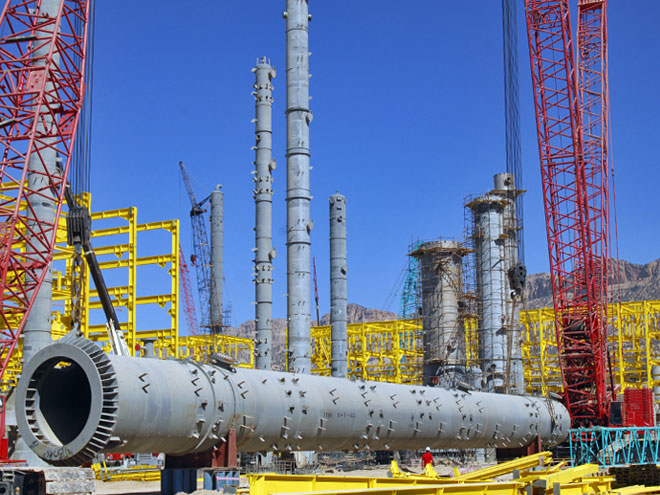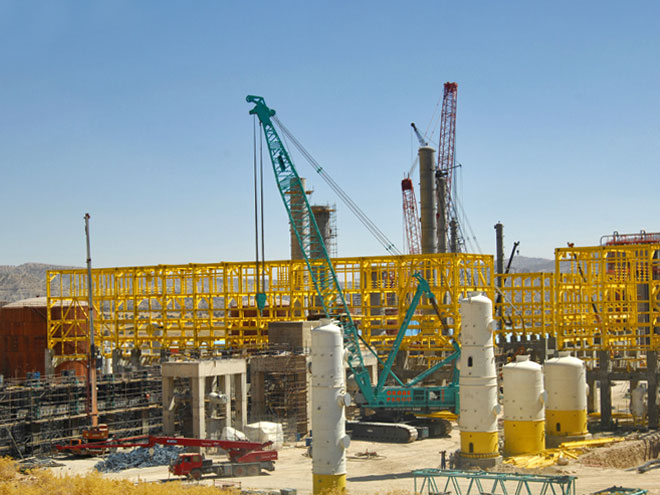Features
MAPNA's Bright Vision in Petrochemical Industry
Despite having a leading position in the world’s hydrocarbon reserves, Iran accounts for roughly 0.6% of the total $3.4 trillion global petrochemical market.
The discovery of oil and the development of cost-effective ways for extracting and transporting oil and gas has changed our world, revolutionizing economies and creating new ways of living for communities. Natural energy sources play a significant role in our everyday lives and global development, particularly in regions with abundant hydrocarbon reserves such as the Middle East.
The petrochemical industry, as an important branch of the oil and gas industry, has had a significant impact on modern industrial life. This key industry has evolved out of oil and gas processing by adding value to low value by-products which have limited use in the fuels industry. The petrochemical sector now produces a remarkable range of useful products that have important applications in almost all areas of modern life.
Although some compounds, such as alcohol, were created long ago through other chemical processes, the discovery of oil and gas paved the way for diversifying the derivation of petroleum-based chemicals.
The first petroleum-based compounds were produced in 1872; carbon black was derived through partial combustion of natural gas, and was used in the production of synthetic rubber. The business evolved in 1920 with the establishment of newer refineries in the United States and the advent of thermal cracking, with the Union Carbide Company pioneering the manufacturing of various ethylene-based compounds in 1923. A British corporation began producing aromatic compounds in the catalytic reforming of petroleum by-products during World War I, and the manufacture of diverse polymer goods prospered from World War II until the 1970s energy crisis.


Petrochemical Industry in Iran
Iran’s privileged position in terms of hydrocarbon feedstock and access to open waters along with the global market demand have made petrochemical industry an undeniable source of value creation in the country’s economy.
The inception of the petrochemical industry in Iran dates back to 1958 when Shiraz Chemical Fertilizer Company was established. In 1964, the National Petrochemical Company (NPC) was founded in line with the plans to expand the industrial horizons.
The launch of projects such as Bandar Imam Petrochemical Company (formerly known as Iran-Japan Petrochemical Company), Farabi Petrochemical Company (formerly: Iran Nippon), and Shiraz Petrochemical Development Project during the years 1964-1986 can be considered the early development phase of Iran’s petrochemical industry.
The rapid development of the petrochemical sector has continued ever since expect for a brief halt in 1986-1988 when the key sector was undergoing transformational changes. In 1988, Bandar Imam Petrochemical Company’s stalled projects were resumed, and new projects were defined and launched through NPC’s funding based on the third, fourth, and fifth Economic Development Plans.
During the fiscal year 2020-2021, Iran’s petrochemical output increased from 66 million tons to 90 million tons. Eleven petrochemical projects were inaugurated last year, with an investment of over $11 billion, resulting in a 10% year-on-year growth in production and a 13% jump in exports. Iran expects to increase output to 100 million tons by 2022, bringing its petrochemical value chain to $25 billion, which will be the highest petrochemical production volume in the region.
During the 2020-2021 fiscal year, petrochemicals accounted for one-third of Iran’s total non-oil exports, bringing in significant revenues for the country. However, Iran still accounts for only roughly 0.6% of the total $3.4 trillion global petrochemical market.
This issue highlights the industry’s urgent need for investment in the coming years. Iran’s oil and petrochemical industries have made great strides in terms of home-grown technology and completing the value chain. If the development plans are realized, the country will be able to produce 153 million tons of petrochemical per year by 2027, but this will require a $28 billion investment.
The petrochemicals industry represents a larger share of the total oil and gas industry, reflecting the higher value of petrochemical products compared to fuels. According to reliable sources, the petrochemical industry will be the driving force of supply, demand and price of oil and gas in the coming years.
MAPNA Footprints in Petrochem Industry
As a leading industrial player, MAPNA Group established Parsian MAPNA Petrochemical Company in Parsian Energy Intensive Industrial Special Economic Zone (PSEZ) in 2020.
In recent years, MAPNA Oil and Gas Division has been actively involved in the utility and process units of oil, gas and petrochemical projects such as Mobin and Damavand Petrochemical complexes in Bushehr Province as well as the South Pars Gas Field phases in the Persian Gulf.
The growing trend of petrochemical projects in domestic and international markets as well as the diversity of required equipment, on the one hand, and MAPNA Group’s capabilities in engineering, procurement, and manufacturing of such equipment and facilities, on the other, have prompted the conglomerate to prioritize petrochemical activities.
Given Iran’s current energy prices, particularly in the gas sector, the petrochemical industry has a better profit margin than other gas-based ventures, allowing MAPNA to cast a special focus on private consumers and foreign markets.
MAPNA Group has embarked on a mega project to build a GTX (gas to petrochemical products) plant in Parsian Energy Intensive Industrial Special Economic Zone (PSEZ).
The GTX plant will produce 1.65 million tons of methanol per year in the first phase, 645,000 tons of olefin per year in the second phase, and 200,000 tons of polyethylene and 465,000 tons of polypropylene in the final phase.
The Group will be completely in charge of project management, production, operation, and sales.
Located in Parsian, Hormozgan Province, along the Persian Gulf, PSEZ’s annual value-added output will be 18 million tons of petrochemicals, 4 million tons of steel, 600,000 tons of aluminum, and 3 million tons of alumina.
MAPNA has purchased the land for the construction project and has agreed with suppliers to buy five million cubic meters of natural gas per day to feed the GTX plant.
The GTX project has officially begun with the establishment of Parsian MAPNA Petrochemical Company. The first phase is estimated to cost around 450 million euros, the implementation of which will help accelerate the development of the next two phases that will need over 1.5 billion euros.
MAPNA Group is currently engaged in several projects in the upstream (exploration, field development and drilling), midstream (processing, transmission and storage) and downstream (refining and petrochemical complexes) sectors; this provides the grounds for the Group to optimize its revenues in the petrochemical value-added chain.
The diverse range of equipment needed in the petrochemical industry give MAPNA Group factories the opportunity to diversify their portfolios. Such an outlook will help the Group to invest, provide services and equipment, and undertake such projects, allowing it to capture a larger portion of the market. MAPNA Group’s vision in the petrochemical industry is not restricted to domestic projects as the Group aspires to promote its brand in the international markets.